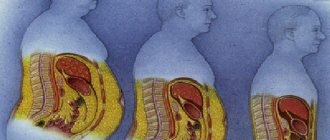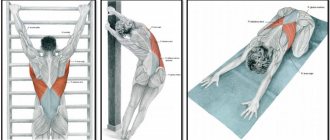Squats with leg raise
Exercise for the hips and buttocks with an emphasis on the riding breeches area.
Place your arms straight on the back of the chair, legs together, do not slouch, and draw in your stomach. Squat down to approximately parallel with the floor. As you straighten up, shift your weight to one leg and lift the other to the side, pulling your toe toward you and pointing your heel up. Return your leg to the starting position, squat down and do the same with the other leg. 1 set – 20 repetitions (10 with each leg).
Perform 3 sets.
Photo: AiF/Eduard Kudryavitsky
What is constipation
Constipation is divided into two types:
Atonic constipation
This type of constipation occurs due to decreased intestinal tone. Due to sluggish peristalsis, the body's waste products pass too slowly through the gastrointestinal tract. The atonic form is more common in older people and in people with a sedentary lifestyle. An unhealthy diet with little dietary fiber can also cause constipation. But it's not that bad. This type of disorder can be corrected, and constipation exercises will help you with this.
Spastic constipation
This type of constipation causes spasms of the intestinal muscles. Feces cannot pass through narrow spaces, causing pain. Bloating and a feeling of heaviness in the abdomen are some of the common symptoms of spastic constipation. Bowel exercises won't help much here. Often, the catalyst for spastic constipation is certain diseases of the body, such as endocrine ones. Stress can also affect bowel function.
Before taking measures to treat constipation, be sure to consult your doctor. Gymnastics for the intestines, or rather some exercises, can aggravate diseases that you do not know about.
Constipation is divided into three stages:
- Compensated
- Subcompensated
- Decompensated
In the first case, few people attach importance to problems with stool. People from 25 to 40 years old are susceptible to this category. Most often, those suffering from this stage try to normalize their bowel movements with diets for constipation. With constipation, people with this category do not have pathological changes.
In stage B, the person experiences more unpleasant sensations. Abdominal pain and bloating significantly reduce quality of life. Lack of bowel movements for two or three days is the main symptom.
In the third case, we are dealing with a severe form of constipation. A week-long absence of bowel movements, pathological changes in the intestines, pain during bowel movements (caused by cracks in the intestinal walls), all this is an incomplete list of symptoms associated with category C.
That is why timely treatment of constipation at an early stage is important. Since these categories merge into one another, reducing the chances of complete relief from the difficulties caused by constipation. Whatever treatment you are prescribed, be it intestinal gymnastics, diet, or medications, it will have a greater effect at the early stage of the disease.
Modern medicine offers a wide range of medications to combat this disease. But as often happens, some medications cause more harm than beneficial properties. Many of them are addictive, so using medications to stimulate peristalsis should be done with extreme caution.
Therapeutic exercises are a direct effect on the intestines, and most importantly not medicinal. Bowel exercises for constipation can significantly improve your condition. You can learn more about some exercises for constipation in adults below.
Intestinal exercises for constipation have a number of contraindications. Therefore, be sure to undergo an examination for an accurate diagnosis. Exercises for constipation, in addition to their direct purpose, will have a good effect on the body as a whole.
Leg Raised Squats
Exercises to work the muscles of the thighs and buttocks on each side.
Standing with your side to a chair, place one foot on the seat. Try not to stand too close to the chair so as not to bend your knee too much. If you can't lift your leg that high, place your knee bent on the seat. Gently squat (at the lowest point you can put your hand on the seat for support). Keep in mind that this is essentially a one-legged squat, so be aware of your strength. Do 5-6 reps and switch sides. 1 set – 10–12 repetitions (equally on both sides).
Perform 2 approaches.
Photo: AiF/Eduard Kudryavitsky
Conclusion
With constipation in adults, more serious diseases of the internal organs can occur. Be sure to consult your doctor if you have irregular bowel movements. If the doctor does not find any serious health problems, try to solve the problem without the use of medications.
Watch your diet, daily routine, regularly do bowel exercises and you will forget about the problem of constipation for a long time.
A healthy person should have a bowel movement every morning. This is ideal; unfortunately, this rarely happens. A disturbance in the functioning of the intestines, the symptom of which is difficulty in defecation, is called “Constipation”.
If you have bowel movements less than three or four times a week, this article will answer your questions:
- What is constipation?
- What causes slow passage of stool?
- What can be done to improve intestinal motility?
Bent Squats
Exercise for hips and buttocks.
Stand on the side of the chair, place your arms bent at the elbows on the seat, preferably holding the opposite edge with your fingers. Feet are slightly closer to the chair than the pelvis, knees are squeezed.
Leaning on your hands, squat on your heels and return to the starting position. 1 approach – 20 repetitions.
Perform 2 approaches.
Photo: AiF/Eduard Kudryavitsky
Preventive recommendations
By following these simple preventive recommendations, you will improve the functioning of your intestines and get rid of constipation:
- drink a glass of warm, clean water every morning;
- eat more fresh vegetables and fruits;
- limit the consumption of fatty, starchy and astringent foods;
- eat regularly, at the same time of day;
- try to get enough sleep;
- be less nervous;
- walk more in the fresh air;
- exercise regularly;
- drink less strong tea and coffee;
- give up dry snacks; you can replace them with prunes and dried apricots;
- eat more cereals;
- Chew your food thoroughly;
- add fiber to cereals and baked goods;
- eat more dairy products.
Additionally, we highly recommend watching the following video
Body transfer
Exercises for the abs, back, back of the arms, chest.
Sit approximately in the middle of the chair, placing your palms on your sides near your hips. Legs slightly bent, feet on the floor not close to the seat. Leaning on your hands, lift your pelvis, move it forward and lower it to the floor. Elbows point outward. 1 set – 8–12 reps.
Perform 2-3 approaches.
Photo: AiF/Eduard Kudryavitsky
What causes constipation
Main reasons:
- Low fiber diet. Lack of sufficient water. Physical inactivity, sedentary lifestyle, lack of physical activity.
- Ulcer, pancreatitis, any tumors.
- Accumulation of solid masses in the intestines
- Problems with the rectum that prevent the colon from emptying feces (anal fissures, hemorrhoids).
- Sclerosis, stroke and other brain diseases.
- Endocrinology
- Drugs have side effects such as constipation.
- Stress and depression have an impact on the intestines
- Pregnancy
Leg Curl
Exercise for the back, arms, abdomen and buttocks.
Rest your arms straight on the seat. The back is tilted, but not slouched, the legs are together. Pull your stomach in. Bend your knees, lowering them towards the floor. At the same time, the legs move to the toes, the knees almost touch the chair when lowering. Leaning on your hands, return your knees to a straight position. 1 approach – 20 repetitions.
Perform 2-3 approaches.
Photo: AiF/Eduard Kudryavitsky
How do such exercises affect the body?
Exercises for constipation have a positive effect on internal organs:
- massage the intestines;
- improve blood circulation;
- strengthen your abdominal muscles, improving your appearance;
- push processed food debris further;
- relieve spasm of smooth muscles;
- remove the feeling of heaviness;
- help get rid of bloating.
There are the following types of training:
- respiratory
- yoga;
- massage or self-massage;
- physiotherapy.
Causes
Why does constipation occur (exercises for bowel movements will be presented below)? There are many reasons for the development of this condition. The most common of them include the following:
- unbalanced diet (for example, consumption of refined and processed foods with insufficient plant fiber);
- lack of a normal/habitual rhythm of life and exposure to stress;
- sedentary lifestyle (including the development of stagnation in the pelvis);
- general diseases (spinal cord diseases, intestinal tumors, diabetes mellitus, hemorrhoids, autoimmune systemic diseases, injuries of the anus and intestines);
- drug abuse, including laxatives.
The cause of episodic constipation is a disruption of the usual lifestyle (for example, while traveling).
Auxiliary methods for restoring bowel function
In addition to exercises for good bowel function, some of the recommendations below may help you:
- Water. Try to consume up to two liters of water per day. Part of the liquid we consume per day is absorbed in the intestines. The more water is present in the body, the more there is in the intestines. The liquid softens the stool, and stool passes more easily. With increasing physical activity in the form of therapeutic exercises for the intestines, the volume of water consumed by the body will increase.
- But this does not mean that from tomorrow you will drink two liters. You need to increase your drinking norm gradually. Every day, add a small amount of fluid to your norm, and then your body will easily get used to it and adapt to the changes.
- Eat small meals. What does it mean? What you need to eat little, but often. On average, the volume of food at a time should not exceed 250-300 grams. But you need to eat every 2.5-3 hours. Eat slowly, crushing food in your mouth. A break from eating can only be done to do intestinal exercises for constipation (video presented). Forget about snacking on fast food.
- Introduce 500 grams of fresh vegetables per day into your diet. Vegetables rich in dietary fiber help stimulate peristalsis.
- Try to give up white bread, canned food, and white flour products.
- Fruits are also a source of fiber, but not all are equally beneficial for the gut. Fruits with astringent taste are contraindicated for people with problems with bowel movements.
- A glass of kefir at night is something your gastrointestinal tract will thank you for.
Together with a drinking regime, fractional meals and exercises to improve bowel function during constipation, you can improve bowel function.
Massage
What exercises help with constipation? First of all, doctors recommend normalizing intestinal function through massage. Regular implementation of such procedures will speed up emptying.
It is advisable to do a massage in the morning, without getting out of bed. First you need to carry out 10 stroking, rubbing and kneading in the navel area in a circular motion, strictly clockwise
.
After this, you need to bend your right leg at the knee, and then, pressing it to your stomach, hold it in this state for several seconds
. Next, you should slowly get out of bed, placing your right foot on the floor first.
To implement another method of massage, you need to soak a towel in cold water and then squeeze it hard. Having wrapped a rag around your right hand, it should be moved from the stomach towards the lower rib (on the right side) and back 5-9 times
. After this, a similar procedure must be performed with the left hand.
If you perform these simple steps every day, you will definitely be pleased with the results.
Signs
Regular exercises for constipation allow patients to get rid of such unpleasant symptoms as:
- stool retention;
- muscle efforts during defecation;
- feeling of bloating and heaviness in the stomach;
- too dry and dense feces (including in the form of balls);
- feeling of incomplete bowel movement.
It should also be noted that chronic constipation is often manifested by signs of dyspepsia, more precisely heartburn, decreased appetite, nausea, flatulence and abdominal pain.
In the chronic course of this pathological condition, intoxication of the body can occur. Against this background, the patient’s condition noticeably worsens
. He develops fatigue, increased irritability, general malaise, headaches and sleep disturbances.
Regular walking
Among the exercises for constipation, for optimal bowel health, you need to do walking. This is the most effective way to normalize the process of defecation, both in adults and in the elderly.
The recommended daily rate is considered to be walking from 3 to 5 km. In addition, it is recommended to take walks in the fresh air while walking.
. What changes occur in the body due to walking:
- Activation of intestinal motility and the entire digestive system occurs. Due to the contraction of the anterior abdominal wall, the large and small intestines are stimulated during constipation.
- The lungs are actively ventilated. When they fully expand during walking, a certain pressure occurs on the diaphragm. When it contracts, massaging movements occur in the area of the upper intestine, which leads to the launch and strengthening of motility
. This is very important against constipation. - Microcirculation increases. Daily walking, like other sports, provokes sufficient blood flow to all organs and systems, enhancing their functions
. This also applies to the rectum, which is very important for constipation.











